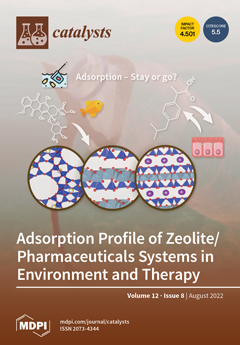α-Imino gold carbenoid species have been recognized as key intermediates in a plethora of processes involving gold-activated alkynes. Here, we explored the pathways of the Au(I)-catalyzed [3 + 2] reaction between the mild nucleophiles: anthranil, 1,2,4-oxadiazole, or 4,5-dihydro-1,2,4-oxadiazole, and an ynamide, PhC≡C-N(Ts)Me, proceeding
[...] Read more.
α-Imino gold carbenoid species have been recognized as key intermediates in a plethora of processes involving gold-activated alkynes. Here, we explored the pathways of the Au(I)-catalyzed [3 + 2] reaction between the mild nucleophiles: anthranil, 1,2,4-oxadiazole, or 4,5-dihydro-1,2,4-oxadiazole, and an ynamide, PhC≡C-N(Ts)Me, proceeding via the formation of the aforementioned α-imino gold carbene intermediate which, after intramolecular capture, regioselectively produces 2-amino-3-phenyl-7-acyl indoles,
N-acyl-5-aminoimidazoles, or
N-alkyl-4-aminoimidazoles, respectively. In all cases, the regioselectivity of the substituents at 2, 3 in the 7-acyl-indole ring and 4, 5 in the substituted imidazole ring is decided at the first transition state, involving the attack of nitrogen on the C1 or C2 carbon of the activated ynamide. A subsequent and steep energy drop furnishes the key α-imino gold carbene. These features are more pronounced for anthranil and 4,5-dihydro-1,2,4-oxadiazole reactions. Strikingly, in the 4,5-dihydro-1,2,4-oxadiazole reaction the significant drop of energy is due to the formation of an unstable α-imino gold carbene, which after a spontaneous benzaldehyde elimination is converted to a stabilized one. Compared to anthranil, the reaction pathways for 1,2,4-oxadiazoles or 4,5-dihydro-1,2,4-oxadiazoles are found to be significantly more complex than anticipated in the original research. For instance, compared to the formation of a five-member ring from the α-imino gold carbene, one competitive route involves the formation of intermediates consisting of a four-member ring condensed with a three-member ring, which after a metathesis and ring expansion led to the imidazole ring.
Full article





